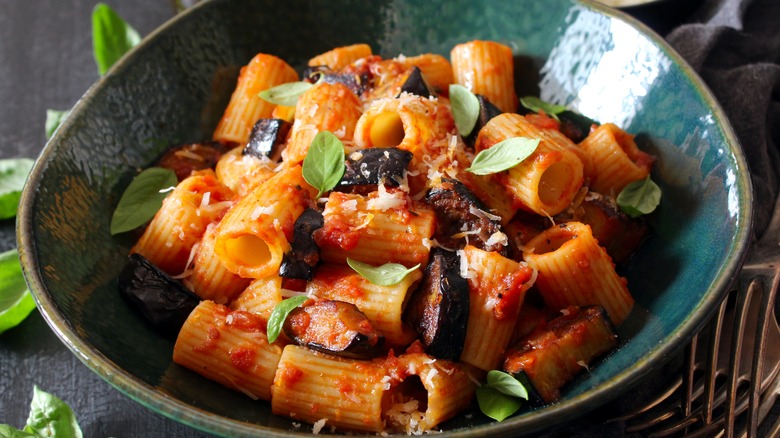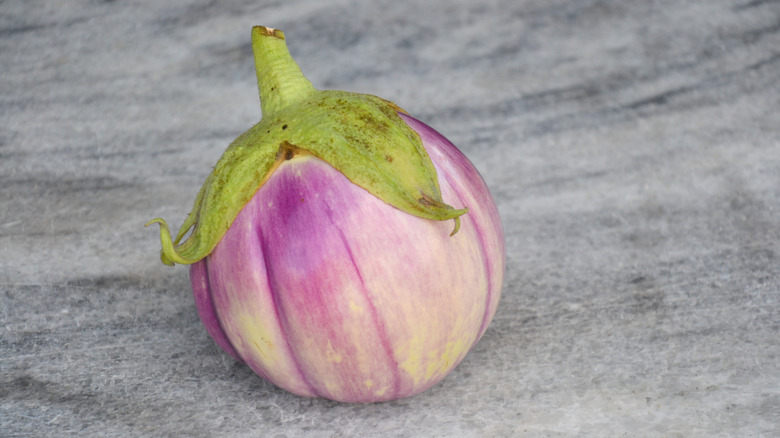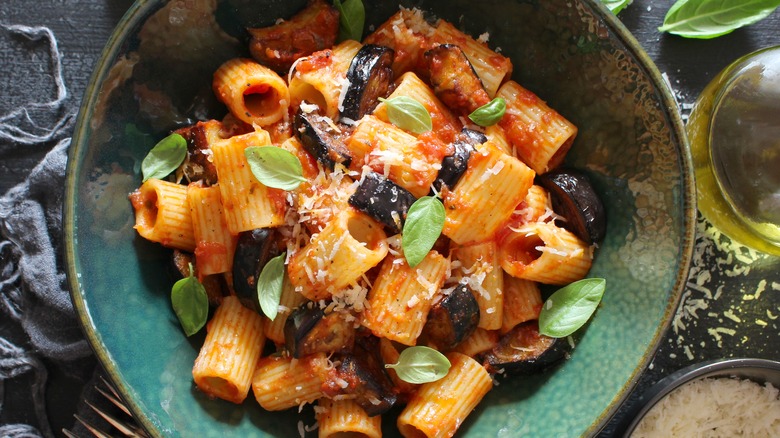Eggplant Is The Star Of The Show In Sicily's Classic Pasta Alla Norma
Look at any list of famous Sicilian foods, and you'll see a thread of usual suspects like cannoli, caponata, arancini, and involtini. However, this list wouldn't be complete without pasta alla Norma. This simple pasta brings together all of the island's most prized ingredients and mixes them into one delicious dish. However, there is one ingredient in pasta alla Norma that stands out for its cultural, and culinary, significance.
Amidst the tomato, basil, garlic, and ricotta — the eggplant, also known as aubergine or melanzana, is the star of pasta alla Norma. Without the eggplant, there would be almost nothing special about this dish. We say "almost nothing" because there is yet another component to pasta alla Norma that makes it so special.
If there is one other thing as encapsulating of Sicilian culture as pasta alla Norma, it's opera. Though the grandiose nature of opera may seem at odds with the rustic simplicity of this dish, there is a connection between the two. The connection comes from a town on Sicily's eastern coast, where, in the early 19th century, one of opera's greatest sons was born.
The operatic origins of pasta alla Norma
The grand tradition of opera is as great an Italian invention as pasta. A blend of dramatic storytelling and epic music, opera was born of the Renaissance and contains some of the Western Canon's most recognizable compositions. Rossini, Verdi, and Puccini, a few of opera's most famous names, were all Italian.
However, as far as pasta alla Norma is concerned, there is only one composer that matters: Vincenzo Bellini. Born in the early 19th century in the coastal town of Catania, Bellini was something of a musical genius. Though he died young at just 34, his operas managed to achieve a great level of fame. His most well-known work was known as "Norma."
How does this relate to pasta? There are two schools of thought. One is that the pasta was first made on the production's opening night and was named in its honor. The other is a little more colorful. According to La Cucina Italiana, another composer from the Eastern Sicilian city of Catania, Nino Martoglio, was so astounded by the eggplant pasta that he proclaimed, "Chista è 'na vera Norma!" meaning "This is a true Norma!" As Bellini's "Norma" is considered a masterpiece, to have a pasta named after it was high praise indeed.
The cultural importance of eggplants
It is difficult to understate just how important eggplant is to the Sicilian diet. A healthy Mediterranean diet consisting of lots of fruits, vegetables, and fish, the eggplant stands out because it is the star ingredient of two of Sicily's most famous dishes: caponata, an agrodolce style salad, and pasta alla Norma. Eggplant arrived in Sicily sometime between the 9th and 10th centuries with the conquering Arabs, who adored eggplant. Like other ingredients from the various cultures that changed hands ruling Sicily, eggplant is ingrained in the island's culinary culture and is oftentimes an alternative to meat.
The variety of eggplant often used to make pasta alla Norma is an heirloom variety called Rosa Bianca. An elegant, round eggplant with pinkish lavender skin, the Rosa Bianca is an exceedingly mild and sweet flavored eggplant with virtually no bitterness. Eggplant didn't reach the Italian mainland until five centuries after it was introduced in Sicily. So though pasta alla Norma is a more recent invention, Sicilians could not have chosen a more special vegetable with which to honor their great composer. These plants, like the pasta dish and opera itself, are a Sicilian masterpiece.
How to make pasta alla Norma
Like all good Sicilian food, pasta alla Norma is easy to make. You can use any variety of eggplant you like, but we highly recommend using Rosa Bianca in order to replicate the authentic flavor of the dish. The eggplant is cut into strips or cubes, seasoned with coriander and salt, then gets fried in olive oil. As the eggplants cook, you'll make the tomato sauce, which is a classic combination of garlic, crushed tomatoes, and basil. The eggplant is added to the sauce, which is left to simmer and collect flavor as the pasta is cooked.
You'll want to use a tubular pasta, like rigatoni, for this dish. The reason is because the tubes of the pasta provide ample space in which the sauce can collect and form pockets of flavor that might otherwise have slipped off a longer pasta like linguine. The sauce and pasta are combined together and finished off with a cheese.
Classically, the finishing cheese for pasta alla Norma is ricotta salata, which is sheep's milk ricotta cheese that has been salt cured so it becomes hard and easy to grate over the pasta. If ricotta salata isn't available, parmesan and pecorino cheese work just as well. So, if you ever find yourself craving eggplant or have an abundant harvest from your garden, do as the Sicilians do and make pasta alla Norma. Pour yourself some red wine and listen to the titular opera for some bonus ambiance.



